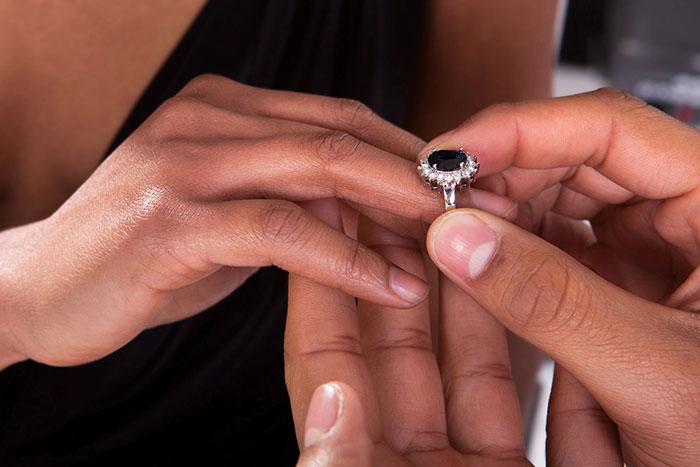Paris, April 1925 and suddenly, everything from engagement rings to your bedroom dressing table was serving geometric lines. The city threw a fancy gathering called the International Exhibition of Modern Decorative and Industrial Arts. Art Deco, the design world’s new crush came decked out in triangles, zigzags, and enough symmetry to make a kaleidoscope jealous.

It was bye-bye, Art Nouveau’s dreamy vines! 1920s newcomer was Art Deco (short for arts décoratifs) Floral motifs were swapped for razor-sharp edges and became the ultimate 1920s/30s fad. Jazz Age rebels? Obsessed. Flappers? Bedazzled. Even your toaster probably looked like a mini Chrysler Building.
A century later, Art Deco’s still the design equivalent of that cool aunt who never goes out of style. Who knew triangles could be this timeless? (Spoiler: Paris did. Obviously)
The History of Art Deco Engagement Rings

While Art Nouveau drew its inspiration from natural forms, Art Deco was inspired by the industrial explosion after WW1 focusing on bold geometric designs. New minerals like Onyx and platinum found their way on to a woman’s hand in an explosion of ideas during the 1920s. Art Deco also made its mark in cosmetic casings, powder compacts and mirrors.
Today, the appeal of vintage gems coupled with Art Deco casings in engagement rings has not faded and the influence of the 1920s era can be found on many of today’s signature pieces.
The Designers
Cartier was the big name. Influenced by the 1922 discovery of King Tutankhamun’s tomb, Cartier incorporated hieroglyphic-inspired patterns and symmetry into their designs. They also popularized platinum for its ability to hold intricate filigree and Milgrain details (Delicate metalwork resembling lace) which was a particular hallmark of Art Deco ring design.
Other leading names in engagement rings in the 1920s included Boucheron, Mauboussin and Van Cleef & Arpels. While not signed, many of their rings were created by true artists. Popular engagement rings used Pavé Settings, which had tiny diamonds set closely together to create a “paved” effect on bands.
What to Look out for in an Art Deco Engagement Ring
Imagine geometry class, but with a dash of dazzle. Art Deco rings from the Roaring ’20s embraced bold shapes—squares, triangles, chevrons—like a love letter to sharp angles, whispering, “Why blend in when you can geometricize?”
Symmetry? Absolutely non-negotiable. These rings were so impeccably balanced, they could’ve moonlighted as architectural blueprints. Clean lines and modernist flair turned every band into a miniature skyscraper for your finger, ready to jazz up even the most spirited flapper’s ensemble.
Diamonds? Vintage vibes only. The era adored Old European cuts, Asscher cuts, and emerald cuts—think less “bling” and more “timeless sparkle with a side of drama.”
Platinum reigned supreme—cool, unshakable, and tougher than a secret password at a speakeasy. It cradled intricate designs like a pro, proving strength and style could indeed be best friends.
Color? No half-measures here. Designers tossed in onyx, sapphires, emeralds, and rubies like they were painting a masterpiece. “Contrast is the name of the game, darling!”
Details? Oh, they mattered. Delicate milgrain beadwork and filigree lace-like metalwork added texture so refined, even the fussiest heirloom linens would tip their hat.
And let’s not forget the global passport stamps—Egyptian motifs, Asian-inspired patterns, African artistry. These rings were the original jet-setters, whispering, “I’ve toured the world… and now I’m on your hand.”
In short: Art Deco rings = 1920s drama meets math-class chic, with a rainbow of gemstones thrown in. Who knew geometry could be this… irresistible?
That’s all !©Glamourdaze
